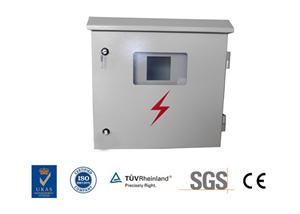판금 굽힘 경험
: 벤딩 머신 톤수 이온
굽힘 공정 동안, 상부 및 하부 다이 사이의 힘이 재료에 가해 져서, 재료가 소성 변형된다. 작업 톤수는 굽힘 중 굽힘 압력을 나타냅니다. 작업 톤수를 결정하는 데 영향을 미치는 요인은 굽힘 반경, 굽힘 방법, 금형 비율, 팔꿈치 길이, 굽힘 재료의 두께 및 강도 등입니다.
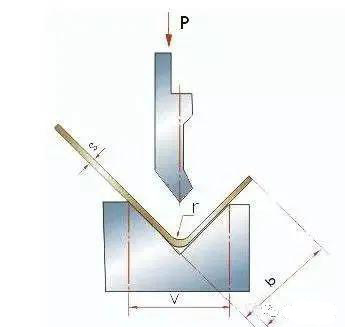
일반적으로 작업 톤수는 다음 표에 따라 처리 매개 변수에서 설정할 수 있습니다.
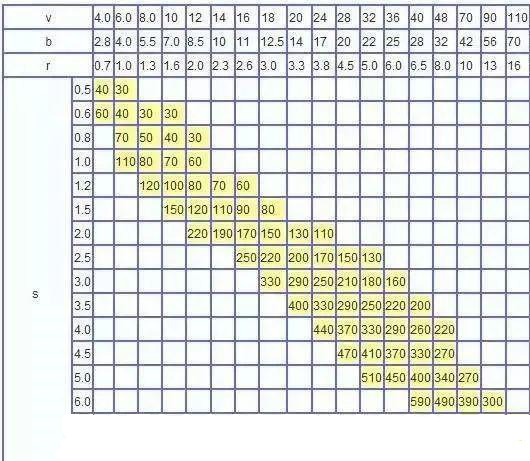
1. 표의 값은 시트 길이가 1 미터 일 때의 굽힘 압력입니다.
예 : S = 4mm L = 1000mm V = 32mm
테이블을 찾아 P = 330kN을 얻습니다.
2.이 표는 강도가 σb = 450N / mm2 인 재료를 기준으로 계산됩니다. 다른 재료를 굽힐 때 굽힘 압력은 표에 나와있는 데이터와 다음 계수의 곱입니다.
브론즈 (소프트) : 0.5;
스테인레스 스틸 : 1.5;
알루미늄 (소프트) : 0.5;
크롬 몰리브덴 강 : 2.0.
3. 굽힘 압력의 대략적인 계산 공식
P = 650s2L / 1000v
P——kn
S—mm
L—mm
V—mm
굽힘 압력 비교표
B. 판금 굽힘에서 일반적으로 발생하는 문제
1) 일반적으로 사용되는 벤딩 다이
아래와 같이 일반적으로 사용되는 벤딩 몰드. 금형의 수명을 연장하기 위해 부품은 가능한 한 둥근 모서리로 설계되었습니다.
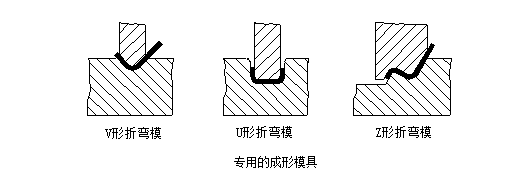
플랜지의 높이가 너무 작 으면 굽힘 다이를 사용해도 성형에 도움이되지 않습니다. 일반적으로 플랜지 높이 L≥3t (벽 두께 포함).
스텝 처리 방법
일부 로우 프로파일 판금 Z 형 스텝 벤딩의 경우 가공 제조업체는 종종 간단한 금형을 사용하여 펀치 또는 유압 프레스를 처리하고 다음 그림과 같이 스텝 형 다이로 벤딩 머신에서 작은 배치를 처리 할 수도 있습니다. 그러나 높이 H가 너무 높아서는 안되며 일반적으로 높이가 (0 ~ 1.0) t이어야하며, 높이가 (1.0 ~ 4.0) t이면 추가 및 배출 구조의 금형 형태의 사용을 고려해야합니다. 실제 조건으로.
이 몰드 스텝의 높이는 심을 추가함으로써 조정될 수 있으므로, 높이 (H)는 임의로 조정될 수 있지만, 길이 (L) 크기가 보장하기 쉽지 않고, 수직면의 수직 성이 쉽지 않다는 단점이있다. 보증. 높이 H 크기가 크면 벤딩 머신에서 벤딩을 고려해야합니다.
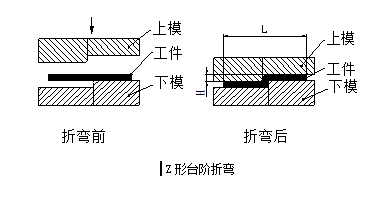
There are two types of bending machine: ordinary bending machine and CNC bending machine. Due to the high precision requirements and irregular bending shapes, the sheet metal bending of communication equipment is generally bent with a CNC bending machine. The basic principle is to use the bending knife (upper die) and V-groove (lower) of the bending machine. Die), bending and forming sheet metal parts.
Advantages: convenient clamping, accurate positioning and fast processing speed;
Disadvantages: low pressure, can only process simple forming, and low efficiency.
Basic principles of forming
The basic principle of forming is shown in the figure below:
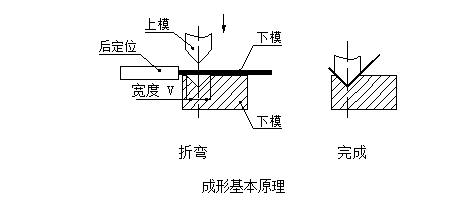
Bending knife (upper die)
The form of the bending knife is shown in the figure below. It is mainly ed according to the shape of the workpiece during processing. Generally, there are many bending knife shapes of processing manufacturers, especially those with a high degree of specialization. In order to process various complex bending , Bending knives of many shapes and specifications are customized.
The lower die generally uses V = 6t (t is the material thickness) die.
굽힘 공정에 영향을 미치는 많은 요인이 있으며, 주로 상부 다이 아크의 반경, 재료, 재료 두께, 낮은 다이 강도, 하부 다이의 다이 크기 및 기타 요인을 포함합니다. 제품의 요구를 충족시키기 위해 제조업체는 벤딩 머신의 안전을 보장하는 조건에서 벤딩 나이프 몰드를 이미 직렬화했습니다. 구조 설계 과정에서 기존 벤딩 나이프 몰드에 대한 전반적인 이해가 필요합니다. 아래 그림을 참조하십시오. 상단 다이는 왼쪽에 있고 하단 다이는 오른쪽에 있습니다.

굽힘 가공 순서의 기본 원리 :
(1) 내부에서 외부로 굽힘;
(2) 작은 것에서 큰 것으로 굽힘;
(3) 특수한 모양을 먼저 구부린 다음 일반적인 모양을 구부립니다.
(4) 이전 프로세스가 형성된 후에는 후속 프로세스에 영향을 주거나 방해하지 않습니다.
The current bending form is generally shown in the following figure:
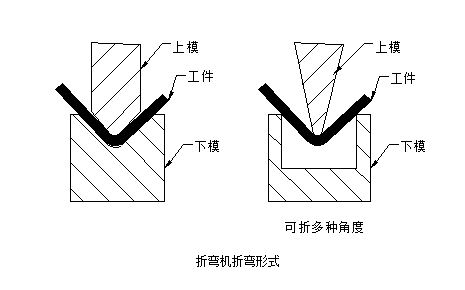
2) Bending radius
When bending sheet metal, a bending radius is required at the bending place. The bending radius should not be too large or too small, and should be ed appropriately. If the bending radius is too small, it is easy to cause cracking at the bending point, and if the bending radius is too large, the bending is easy to rebound. The preferred bending radius (inner bending radius) of various materials with different thicknesses is shown in the table below
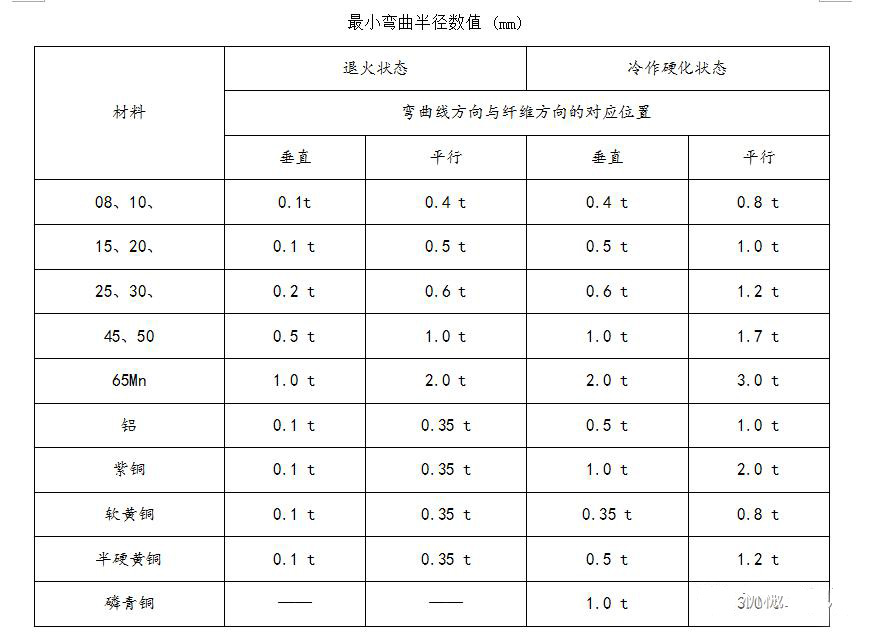
The data in the table above is the preferred data, for reference only. In fact, the corners of manufacturers' bending knives are usually 0.3, and a small number of bending knives are 0.5.
For ordinary low-carbon steel plate, rust-proof aluminum plate, brass plate, copper plate, etc., the inner fillet 0.2 is no problem, but for some high-carbon steel, hard aluminum, super hard aluminum, this bending round It will cause bending breakage or cracking of the outer corners.
3) Bending and rebound
Springback angle Δα = b-a
Where b——the actual angle of the part after rebound;
a—The angle of the mold.
The size of the rebound angle
See the table below for the springback angle when a single angle is 90 ° free bending.
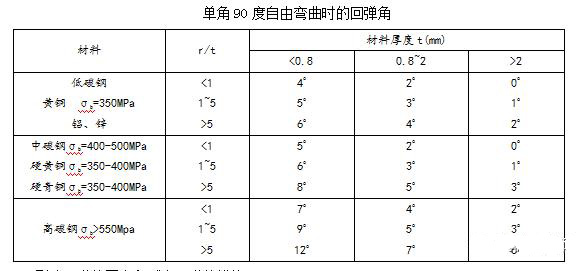
Factors affecting rebound and measures to reduce rebound
① The mechanical properties of the material The rebound angle is directly proportional to the yield point of the material and inversely proportional to the elastic modulus E. For sheet metal parts with high accuracy requirements, in order to reduce springback, the material should be ed as low-carbon steel as possible, not high-carbon steel and stainless steel.
② The larger the relative bending radius r / t, the smaller the degree of deformation and the greater the rebound angle Δα. This is a relatively important concept. The rounded corners of sheet metal bending should be as small as possible, as long as the material properties allow, to improve accuracy. In particular, pay attention to avoid designing large arcs as much as possible, as shown in the following figure, such large arcs have greater difficulty in production and quality control:
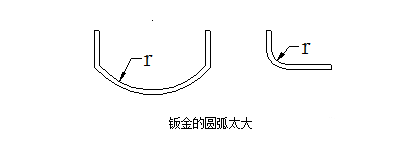
4) Calculation of the minimum bending edge in one bending
The initial state of the L-shaped bend at the time of bending is shown below:
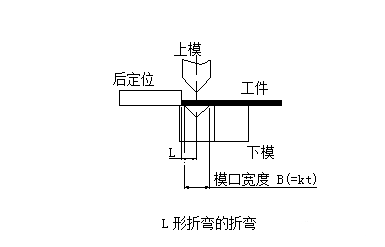
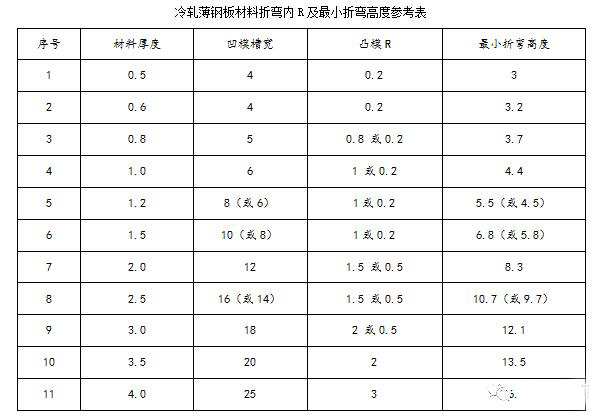
The initial state of the Z-shaped bending at the time of bending is shown in the figure below

The minimum bending dimension L corresponding to the Z-bending of sheet metal with different material thickness is shown in the following table:
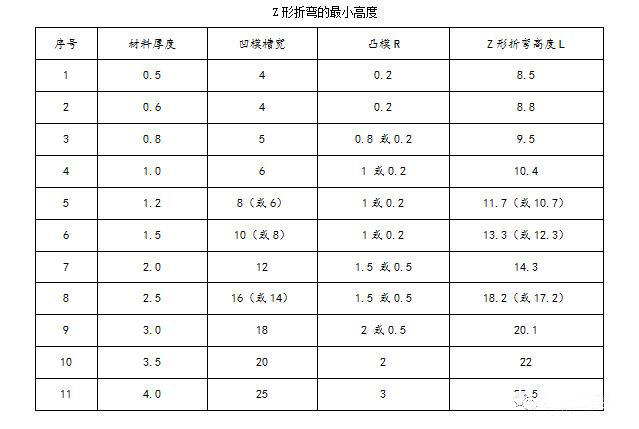
C. Fast calculation method of sheet metal bending and unfolding
When the sheet metal bending and flattening, one side of the material will be elongated and one side will be compressed. The factors affected are: material type, material thickness, material heat treatment and processing bending angle.
Expand calculation principle:
1) During the bending process, the outer layer is subjected to tensile stress and the inner layer is subjected to compressive stress. Between tension and compression, there is a transition layer that is neither tensile nor compressive, called the neutral layer; the neutral layer is bent during the bending process The length is the same as before bending, so the neutral layer is the benchmark for calculating the unfolded length of the bending piece.
2) The position of the neutral layer is related to the degree of deformation. When the bending radius is large and the bending angle is small, the degree of deformation is small. The position of the neutral layer is close to the center of the sheet thickness; when the bending radius becomes small, the bending angle increases When it is large, the degree of deformation increases accordingly, and the position of the neutral layer gradually moves to the inside of the bending center. The distance from the neutral layer to the inside of the sheet is expressed by λ.
On the other hand, with the emergence and popularization of computer technology, in order to make better use of the computer's super analysis and calculation capabilities, people increasingly use computer-aided design, but when computer programs simulate the bending of sheet metal Or it needs a calculation method in order to accurately simulate the process.
Although only to complete a certain calculation, each store can customize a specific program according to its original pinch rules, but nowadays, most commercial CAD and three-dimensional solid modeling systems have provided more general and Powerful solution.
대부분의 경우 이러한 응용 프로그램 소프트웨어는 원래의 경험 기반 및 손가락 꼬집음 규칙과 호환 될 수 있으며 특정 입력 내용을 계산 프로세스에 맞게 사용자 지정할 수있는 방법을 제공합니다. SolidWorks는 당연히이 판금 설계 기능을 제공하는 리더가되었습니다.




